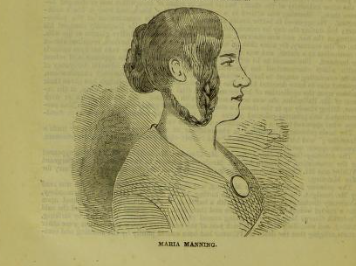As I have been mentioning (rather a lot!) in recent posts, I am currently pulling together a few thoughts on coverture for what one might generously describe as ‘a paper’, for a conference on that topic.[i] The content will be mostly medieval, with a few links to the law and legal history of the present.[ii] I do enjoy delving into a bit of 19th and early 20th C ‘public awareness’ stuff too though,[iii] and the thing which really strikes me about discussions of coverture in that period is the level of opposition based not on ideas about oppression and limitation of women’s lives, but about the ill effects coverture might have on men, or the ways in which women might use it to their advantage (unfairly, of course …) to escape some liability. I have touched upon this sort of thing in a previous post concerning the deployment of coverture as a (sneaky) way of escaping debts. Another implication of coverture, which seems to have caused exaggerated fear amongst Victorian newspaper readers and writers, arose in a more felonious context: there was concern that women might take advantage of ‘marital coercion’ to weasel out of the consequences of serious crime.
Since well before the Norman conquest, English law has had some idea of taking into account the possibility that a wife might participate in offending conduct not because she chooses to do so, and is generally a bad lot, but because her husband forces her to offend, or to join in his misconduct in one way or another.[iv] Early accounts are focused upon theft, and to suggest that there was ever a broad ‘doctrine of marital coercion’, such as might be used to avoid the consequences of homicide, would be a fairly large exaggeration. This spectre was, however, raised in the 19th C press. We can definitely see it in accounts of ‘The Bermondsey Murder’ and its aftermath in newspapers of 1849.
The story of this much-discussed homicide was as follows:[v] a man called Patrick O’Connor had been shot with a pistol, and bashed over the head for good measure, in Bermondsey. Result: death. His ‘mutilated remains’ were found in August 1849, (and the corpse’s false teeth seem to have played some part in identification). Suspicion fell upon a married couple, the Mannings.[vi] Mrs (Maria) Manning was caught in Edinburgh and Mr (Frederick Charles) Manning was caught in Jersey.[vii] He then said that Mrs Manning had instigated the whole thing and fired the shot to the head of O’Connor (as he went down some stairs). Amongst the general enjoyment of a horrible crime, and the potential of a bit of scandal, there was, apparently, some concern that ‘the law of coverture’ would let Mrs Manning off the hook (or the gallows …). That people might be concerned about this was implied by a letter to the Times by one ‘W.E.K.’ of Lincoln’s Inn Fields.[viii] Was this a response to genuine concern or a gratuitous display of having read a bit of obscure law? I am not sure. In any case, W.E.K., plonking down the authority of Hale, reassured Times readers that ‘the plea of “coverture” being urged as a shield over the acts of Mrs Manning’ would not actually work in this context. As he put it, ‘The public may rest satisfied that the plea of coverture will not shield Mrs Manning from the sword of offended justice.’ Phew – so that was all right. The pair, having sold a lot of newspapers, were convicted and executed.[ix]
The ’marital coercion’ point was not the only ‘coverture’ point relating to this case. We also have discussion of property and allegiance aspects. The property point arose once both the Mannings had been apprehended, when there was something of a dispute as to how to deal with the money found on Mrs Manning at her arrest. Could Mr Manning have it (at least, some of the money not obviously pinched from Mr O’Connor) for his defence, because … coverture and all …[x] That whole ‘man gets all the personal property’ part of coverture could certainly be a bit of a problem in the situation in which spouses were both accused of a crime and were going a bit ‘cut throat’ in their defence, with separate representation to fund … The allegiance point related to jury composition. ‘Coverture’ meant Mrs Manning was unable to secure a trial by a jury made up half of aliens, as she wished, because she had married an Englishman.
Finally, and more of a ‘women in general’ point than a coverture point as such, there is endless fascination in the gendered nature of reporting of criminal defendants. Far more attention is paid to the clothes and appearance of Maria Manning than is the case in relation to her husband. It also seems very important to know how attractive she was (woman accused of murder: hot or not?). The authoritative view given in the Times of 24th August, 1849 was that, while she was ‘very neatly dressed’, and had ‘easy and graceful manners’, she was not ‘by any means what may be styled beautiful, as some of the papers have asserted’. Ah, glad we cleared that up. Obviously deserved to hang then.
GS
16/4/2022.
Image: Maria Manning, from this. Officially not beautiful, right?
[i] Still looks more like a collection of individual points as opposed to a coherent whole – hey, a bit like coverture itself … and I have in no way just gone in my head from the idea of a paper on coverture to the fact that, in ‘rock, paper, scissors’, paper covers rock ….
[ii] Sorry, early modernists, once again your period is being treated as ‘the flyover centuries’ … love you really …
[iii] i.e. doing lazy online searches of old newspapers …
[iv] Shameless self-citation – see c.6 of my Women in the Medieval Common Law. Other accounts are available.
[v] Times, 18th August, 1849 onwards: there seem to be daily reports,
[vi] Mrs Manning, nee Maria Rue/ de Roux, was ‘a native of Geneva’, or of Lausanne, though I am sure that her foreignness had nothing to do with the negative attitude of the press …The suggestion was that O’Connor and she were ‘at it’.
[vii] Lots of detail on detectives, police co-operation etc., for those who like that sort of thing; also note that Mr Manning, on the run, was tucked up in bed by 9.30 – a slightly incongruous touch?
[viii] Times, 29th August, 1849.
[ix] Times, 14th November, 1849. I am, no doubt, sounding rather flippant, but, as well as acknowledging that this is all grim beyond words, I do have a serious academic concern relating to this material, It is this – I note that a fair amount of modern scholarship on coverture takes the line that women (implicitly a fair number of them), rather than being ‘helpless victims’ of coverture rules, managed to use their artificial relegation from full personhood to their own benefit. We should, I think, at least pause to note that this idea of flipping an oppressive doctrine to one’s own advantage was present in the minds of those deeply invested in maintaining discriminatory structures.
[x] Times 5th September, 1849.

